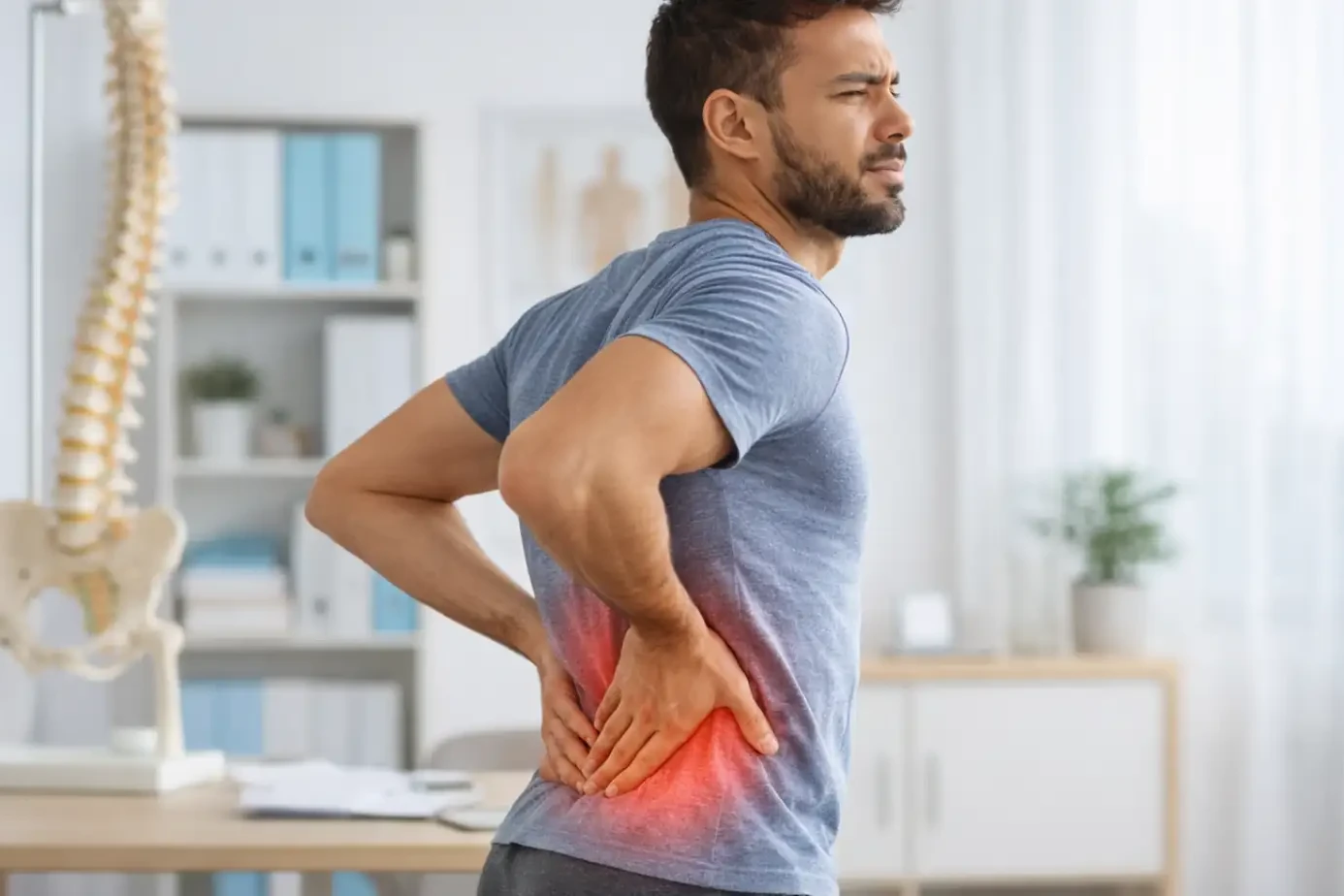If you’re dealing with chronic pain, you’re in good company. Millions worldwide face various types of discomfort, like joint pain, headaches, and muscle aches. Many turn to natural remedies instead of over-the-counter drugs for relief. This article will cover natural ways to ease pain safely and effectively.
Natural pain relief often targets the root causes of pain, like inflammation. By using these holistic methods, you can ease pain and boost your health. Whether it’s joint pain, headaches, or ongoing discomfort, the remedies here might help you feel better and live better.
Table of Contents
ToggleEssential Oils for Pain Relief
Let’s look at the calming effects of lavender oil and rosemary oil. These essential oils for pain relief are getting attention for their healing powers.
Lavender Oil
Lavender essential oil is famous for its calming effects. Studies show that breathing in lavender oil or putting it on the skin can lessen pain during medical procedures. It might also ease pain, reduce swelling, and fight off harmful germs in animals.
Rosemary Oil
Rosemary oil is another option for easing pain. Research finds it helpful for anxiety, depression, and other diseases. It’s also good for headaches, muscle pain, and seizures.
Rosemary oil can ease pain in those going through opium withdrawal and lessen swelling. It relaxes muscles and can improve memory too.
Remember, always mix essential oils with a carrier oil like olive oil before use. This makes them safe and effective for skin use or breathing in.

Peppermint Oil: A Natural Analgesic
Peppermint oil is a natural way to ease pain. It comes from the Mentha piperita L. plant. This oil has anti-inflammatory, antimicrobial, and pain-relieving properties. These properties help with various discomforts.
A 2015 review found peppermint oil helps with painful spasms and arthritis issues. You can use diluted peppermint essential oil on your skin. Just rub it gently on the painful area. It can help soothe aches and pains.
Peppermint oil’s active parts, menthol and menthone, cause a cooling sensation. This helps with pain relief. It can also help with irritable bowel syndrome (IBS) and functional dyspepsia if taken as a supplement.
But, remember to use peppermint oil safely. Don’t swallow it, as it can cause heartburn, nausea, and vomiting. Always talk to a healthcare professional before using peppermint oil for pain relief.

Eucalyptus Oil for Arthritis Pain
If you’re looking for natural ways to ease pain, consider eucalyptus oil. This essential oil comes from the Eucalyptus tree. It has been shown to help people with arthritis pain.
A 2022 study found that inhaling eucalyptus oil for just 5 minutes, 3 times a day, helped reduce pain. It also improved the quality of life for people with rheumatoid arthritis. The oil’s anti-inflammatory and analgesic properties may help with swelling and discomfort.
Eucalyptus oil is generally safe when used right. But, it should be kept away from children because it can slow down breathing if swallowed. Always mix it with a carrier oil like coconut or almond oil before applying it to your skin. Do a patch test first to check for any skin reactions.

Along with eucalyptus oil, try other natural remedies for arthritic pain. Some good options include:
- Lavender oil for its soothing and anti-inflammatory effects
- Ginger oil to help reduce inflammation and pain
- Frankincense and myrrh for their potential joint-supporting properties
Remember, these natural solutions may help, but always talk to your healthcare provider before trying new treatments. With the right advice, you can use eucalyptus oil and other natural remedies to manage your arthritis pain well.
Cloves: A Traditional Toothache Remedy
For centuries, people have used cloves to ease toothache pain. Clove oil has been a key part of dentistry since the 19th century. It’s known for its strong pain relief and germ-fighting properties.
Eugenol in cloves numbs the pain and helps with toothaches. Studies show clove oil works as well as ice and better than some common anesthetics in kids. It’s a strong pain reliever.
Clove oil also fights inflammation, fungus, and viruses. This makes it a great natural fix for many dental problems. Zinc oxide eugenol, a common dental filling, uses clove oil too.
But, be careful with cloves. Using clove oil wrong can harm your gums, teeth, and skin. Pregnant women and kids should be extra careful with it.
For quick toothache relief, over-the-counter painkillers like acetaminophen and ibuprofen work well. Dental gels with anesthetics can also numb the pain. But, don’t give these to kids under 12.
If your toothache is bad or doesn’t go away, see a dentist. Not treating it can lead to serious infections. A dentist can find and fix the real problem.

Cloves have been a go-to for toothaches for a long time. But, use them with care and talk to a doctor if the pain doesn’t get better. Knowing the good and bad of cloves can help you choose the best for your teeth.
Capsaicin: Nature’s Powerful Painkiller
One ingredient that shines for natural pain relief is capsaicin, found in chili peppers. Studies show capsaicin’s power to ease different kinds of pain, like neuropathic pain.
Capsaicin for Neuropathic Pain
A 2020 study showed capsaicin helps with pain, sleep, fatigue, depression, and life quality for those with neuropathic pain. A 2021 study also found topical capsaicin cuts down neuropathic pain. It does this by lowering chemicals that send pain signals from nerve cells in the painful area. This might cause a mild burning or tingling feeling when applied.
Capsaicin makes up about 1% of chili peppers’ mass, with more in the seed area. It absorbs well when used on the skin or taken by mouth, reaching up to 94% absorption.

Capsaicin and similar compounds help with many pain issues. They work by targeting specific nerve cells and lowering pain sensitivity in rats and humans. Capsaicin also boosts certain proteins that help the NMDA receptor, a key pain transmitter.
With its natural pain-fighting abilities, capsaicin is a great choice for those looking for natural relief, especially for neuropathic pain. Adding capsaicin-rich foods or products to your daily life could be a safe, effective way to ease your pain.
Ginger: A Natural Anti-Inflammatory
Ginger, also known as Zingiber officinale, is a powerful root. It has been used for a long time to help with pain and reduce inflammation. Studies show it works well for joint pain, muscle soreness, and headaches.
A 2017 study showed ginger powder worked just as well as ibuprofen for pain after surgery. Another study in 2015 found that eating 2 grams of ginger a day helped with muscle pain from exercise. It could make recovery faster and lessen inflammation from working out.
Ginger is known for its anti-inflammatory effects. A review of 16 studies with 1,010 people found that taking 1,000–3,000 mg of ginger daily for 4–12 weeks lowered inflammation. This included reducing C-reactive protein (CRP) and tumor necrosis factor-alpha (TNF-α).
People with osteoarthritis who took 500–1,000 mg of ginger daily saw less joint pain and improved mobility. They also had lower levels of inflammatory markers like TNF-α and interleukin 1 beta (IL-1β). Research suggests ginger can also help with cluster headaches.
While ginger is usually safe, it might increase bleeding risk for those on anticoagulants. It’s a good idea to talk to a healthcare professional before using ginger for pain relief.

Feverfew: An Herbal Remedy for Migraines
Feverfew, also known as featherfew or bachelor’s buttons, is a plant with a long history. It’s been used for many health issues. Some people think it could be a good herbal migraine remedy and natural way to ease pain.
Studies say feverfew has compounds that might lessen inflammation and muscle spasms. These are big factors in causing migraine headaches. The American Migraine Foundation says the results on feverfew for preventing migraines are mixed. But, it thinks it could help some people.
A 2023 study found that feverfew could have anti-inflammatory, antioxidant, and neuroprotective effects. This makes it a promising natural choice for those looking for feverfew, herbal migraine remedy, and natural pain relief. But, finding the best dose and checking safety over time is still being looked into.

If you’re thinking about trying feverfew for migraines or pain, talk to your doctor first. Feverfew might not mix well with some medicines or could have side effects, especially for pregnant people. Overall, feverfew looks promising as an herbal migraine remedy and natural pain relief option. But, we need more studies to know for sure how well it works and if it’s safe.
Turmeric: A Powerful Natural Pain Reliever
Turmeric is a bright spice often found in Indian dishes. It’s known for its health perks. The key ingredient, curcumin, fights inflammation and helps with pain. This makes it a good choice instead of regular painkillers.
A 2021 review showed curcumin can ease pain as well as some over-the-counter drugs. But, experts suggest adding turmeric to your current pain treatment, not replacing it. Turmeric works more slowly and isn’t as strong as some medicines.
You can add turmeric to many foods for its pain-relieving benefits. Put it in curries, smoothies, or juices. It makes food taste better and helps your body fight inflammation. This could lessen pain and discomfort.
Even though turmeric is usually safe, talk to your doctor before using it. This is especially true if you’re on other medicines or have health issues. Using turmeric can be a natural way to handle pain and improve your health.
Acupuncture for Natural Pain Management
For those looking for natural pain relief, acupuncture could be a good choice. Acupuncture uses thin needles at certain body points to balance energy and help nerves, muscles, and tissues. This ancient Chinese method is now popular in the U.S. as a way to handle chronic pain.
Acupuncture Benefits
Studies show acupuncture can help with pain. The National Center for Complementary and Integrative Health says it can ease musculoskeletal pain, headaches, and osteoarthritis pain. A 2018 study found acupuncture helps with chronic pain, especially for musculoskeletal, headache, and osteoarthritis pain.
More research is needed on acupuncture for other pain issues. But, the evidence shows it can be a great option for managing pain naturally. Many people have seen big improvements, not just in pain, but also in sleep, energy, and stress levels.
Acupuncture is a safe, natural way to ease pain. With skilled practitioners, the risks are low. It’s a good choice for those wanting to avoid just relying on drugs. If you’re struggling with chronic pain, headaches, or joint pain, acupuncture might be something to think about for your pain relief plan.
Yoga for Pain Relief
If you’re looking for natural ways to ease pain, yoga could be a good choice. It’s a mix of physical and mental exercises that can help with back pain, neck pain, and chronic issues like arthritis and fibromyalgia. Yoga uses gentle stretches, strengthening moves, and relaxation to lessen pain and boost your health.
Yoga is great for improving flexibility and movement. Poses like Cobra Pose (Bhujangasana) and Child’s Pose (Balasana) focus on muscles and joints that often hurt. This can make moving easier and reduce stiffness. Yoga also teaches deep breathing and mindfulness to calm the mind and body, which can lessen pain.
Studies show yoga is effective for different kinds of pain. For example, a 2020 study found yoga cut down lower back pain after 12 weeks. The National Center for Complementary and Integrative Health (NCCIH) says yoga might help with lower back and neck pain. But, more research is needed for other conditions like headaches, arthritis, or fibromyalgia.
Starting with yoga for pain relief? Begin with easy practices and find a skilled teacher to help with proper form and adjustments. Adding yoga to your routine, along with a diet full of nutrients that help with pain, could lead to better health and a more active life.
Mindfulness Meditation: A Mind-Body Approach
If you’re dealing with chronic pain, mindfulness meditation might help. It’s a mind-body method that’s becoming more popular for natural pain relief. Studies show it can lessen pain, improve mood, and enhance life quality.
A 2017 review looked at 38 studies on this topic. It found that mindfulness meditation is a good way to manage chronic pain. More research is needed, but it looks promising as an extra or alternative to usual pain treatments.
- Mindfulness meditation means focusing on now, often by watching your breath or body sensations.
- This helps you notice your thoughts and feelings better. It lets you handle pain and stress with more acceptance and kindness.
- Doing it regularly can make pain less intense and reduce feelings of depression and anxiety.
Starting with meditation? Take it slow and be kind to yourself. Just a few minutes a day can make a big difference over time. Talk to your doctor about adding mindfulness meditation to your natural pain relief plan.
Natural Pain Relief
Many people are now looking for natural remedies instead of traditional pain meds. These options can be safe and effective, especially for those wanting to avoid prescription drug side effects. There are many natural pain relief methods to try, from essential oils to herbal supplements.
Turmeric is a spice from Indian cooking that’s known for its pain relief. It has a compound called curcumin that fights inflammation and reduces pain. Ginger is another spice that helps with chronic pain because it’s anti-inflammatory.
- Acupuncture, an ancient Chinese practice, helps with chronic pain like knee osteoarthritis, back pain, and fibromyalgia.
- Mindfulness meditation and cognitive-behavioral therapy (CBT) help manage chronic pain by teaching coping skills and reducing stress and anxiety.
- CBD oil, from the hemp plant, is effective for chronic pain from conditions like multiple sclerosis, arthritis, and neuropathic pain.
Remember, not every natural remedy works for everyone. You might need to try a few to see what helps you the most. Always talk to a healthcare professional before starting any new supplements or therapies to make sure they’re right for you.
Conclusion
This article looked at many ways to ease pain naturally, like essential oils, herbal remedies, acupuncture, yoga, and mindfulness. While some need more study, many have found relief with these natural methods. Always talk to a doctor before trying new remedies, especially if you have health issues or take other drugs.
Looking into natural pain relief can help you find what works best for you. Essential oils and turmeric can ease pain without the risks of some medicines. You might try acupuncture, yoga, or a mix of therapies to manage pain better. This holistic way can help you control your health and find lasting relief.
Don’t be shy to try the natural remedies talked about here and talk to your doctor for a full plan. Starting your health journey with natural solutions can help ease your pain and better your life quality.
FAQ
What are some natural ways to relieve pain?
There are many ways to ease pain naturally, like using essential oils and herbal remedies. You can try lavender oil, rosemary oil, peppermint oil, eucalyptus oil, and cloves. Capsaicin, ginger, feverfew, turmeric, acupuncture, yoga, and mindfulness meditation also help.
How can lavender oil help with pain relief?
Studies show that lavender oil can lessen pain when inhaled or applied to the skin. It’s known for its pain-relieving, anti-inflammatory, and antioxidant effects.
What are the benefits of rosemary oil for pain relief?
Rosemary oil might help with headaches, muscle, and bone pain, and seizures. It can also ease pain in those going through opium withdrawal. Plus, it reduces inflammation, relaxes muscles, and boosts memory.
How can peppermint oil be used for pain relief?
Peppermint oil has anti-inflammatory and pain-relieving properties. Applying it to the temples and forehead can ease tension headaches. People often mix it with a carrier oil and rub it on sore areas.
How can eucalyptus oil help with arthritis pain?
A study in 2022 showed that eucalyptus oil helped reduce pain and improve life quality in people with rheumatoid arthritis. It should be mixed with a carrier oil and used carefully, as it can be harmful if swallowed.
How can cloves be used to relieve toothache pain?
Cloves have long been used to ease toothache pain. A 2021 study found that clove oil worked as well as ice and was stronger than a local anesthetic during dental procedures in children.
How can capsaicin help with neuropathic pain?
Capsaicin can lessen neuropathic pain, according to a 2021 study. It does this by reducing chemicals that carry pain signals from nerve cells in the affected area.
What are the pain-relieving benefits of ginger?
Ginger has been shown to be as effective as ibuprofen in reducing post-surgery pain. A 2015 review found that ginger helped reduce muscle pain from exercise and running.
How can feverfew help with migraines?
Feverfew is often used for migraines. While its effectiveness varies, it’s thought to help prevent migraine headaches. A 2023 study suggests it has anti-inflammatory and antioxidant effects.
What are the pain-relieving properties of turmeric?
Turmeric contains curcumin, which helps with pain. A 2021 review found that curcumin can reduce pain as well as some drugs do. It’s recommended as a supplement to pain medications, not a replacement.
How can acupuncture help with pain management?
Acupuncture can help with pain, including musculoskeletal, headache, and osteoarthritis pain. A 2018 study found it effective for chronic pain.
What are the pain-relieving benefits of yoga?
Yoga has been shown to reduce lower back pain, according to a 2020 study. The National Center for Complementary and Integrative Health suggests it may help with lower back and neck pain, but not other types of pain.
How can mindfulness meditation help with chronic pain?
Mindfulness meditation can improve pain, depression, and quality of life for those with chronic pain, a 2017 review found. However, more research is needed to fully understand its benefits.
Source Links
About The Author

This article is medically reviewed by Dr. Chandril Chugh, Board-Certified Neurologist, providing expert insights and reliable health information.
Dr. Chandril Chugh is a U.S.-trained neurologist with over a decade of experience. Known for his compassionate care, he specializes in treating neurological conditions such as migraines, epilepsy, and Parkinson’s disease. Dr. Chugh is highly regarded for his patient-centered approach and dedication to providing personalized care.
→ Book a consultation to discover which remedies suit your needs best.




